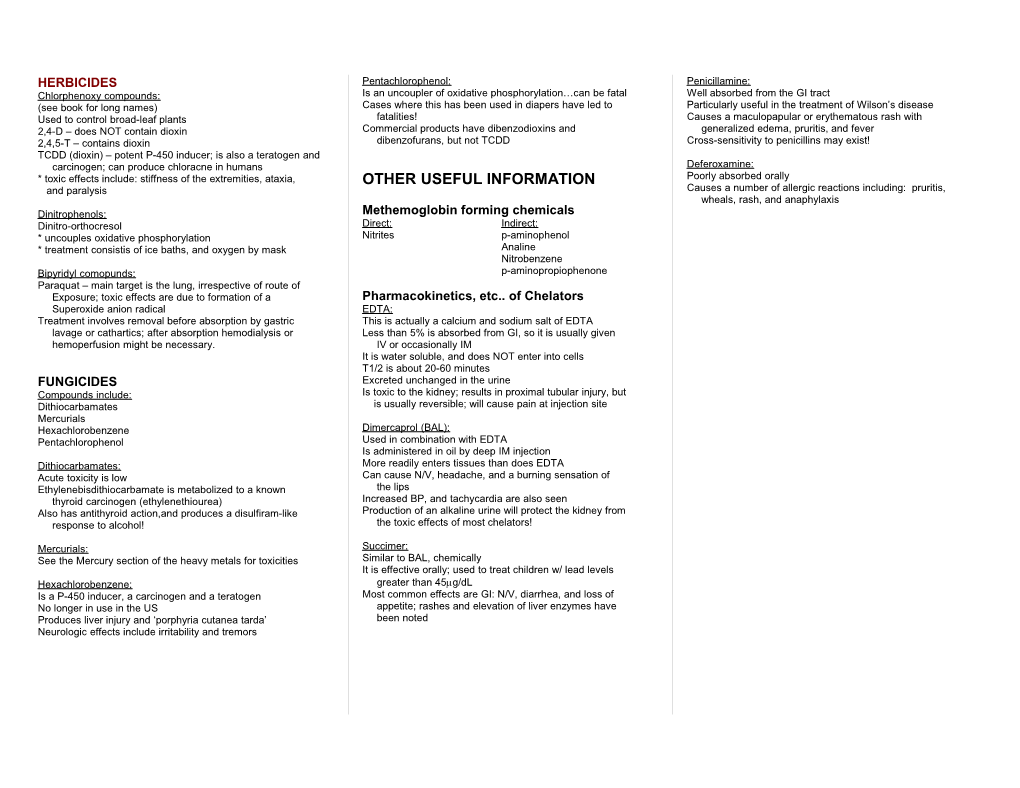HERBICIDES
Chlorphenoxy compounds:
(see book for long names)
Used to control broad-leaf plants
2,4-D – does NOT contain dioxin
2,4,5-T – contains dioxin
TCDD (dioxin) – potent P-450 inducer; is also a teratogen and
carcinogen; can produce chloracne in humans
* toxic effects include: stiffness of the extremities, ataxia,
and paralysis
Dinitrophenols:
Dinitro-orthocresol
* uncouples oxidative phosphorylation
* treatment consistis of ice baths, and oxygen by mask
Bipyridyl comopunds:
Paraquat – main target is the lung, irrespective of route of
Exposure; toxic effects are due to formation of a
Superoxide anion radical
Treatment involves removal before absorption by gastric
lavage or cathartics; after absorption hemodialysis or
hemoperfusion might be necessary.
FUNGICIDES
Compounds include:
Dithiocarbamates
Mercurials
Hexachlorobenzene
Pentachlorophenol
Dithiocarbamates:
Acute toxicity is low
Ethylenebisdithiocarbamate is metabolized to a known
thyroid carcinogen (ethylenethiourea)
Also has antithyroid action,and produces a disulfiram-like
response to alcohol!
Mercurials:
See the Mercury section of the heavy metals for toxicities
Hexachlorobenzene:
Is a P-450 inducer, a carcinogen and a teratogen
No longer in use in the US
Produces liver injury and ‘porphyria cutanea tarda’
Neurologic effects include irritability and tremors
Pentachlorophenol:
Is an uncoupler of oxidative phosphorylation…can be fatal
Cases where this has been used in diapers have led to
fatalities!
Commercial products have dibenzodioxins and
dibenzofurans, but not TCDD
OTHER USEFUL INFORMATION
Methemoglobin forming chemicals
Direct:Indirect:
Nitritesp-aminophenol
Analine
Nitrobenzene
p-aminopropiophenone
Pharmacokinetics, etc.. of Chelators
EDTA:
This is actually a calcium and sodium salt of EDTA
Less than 5% is absorbed from GI, so it is usually given
IV or occasionally IM
It is water soluble, and does NOT enter into cells
T1/2 is about 20-60 minutes
Excreted unchanged in the urine
Is toxic to the kidney; results in proximal tubular injury, but
is usually reversible; will cause pain at injection site
Dimercaprol (BAL):
Used in combination with EDTA
Is administered in oil by deep IM injection
More readily enters tissues than does EDTA
Can cause N/V, headache, and a burning sensation of
the lips
Increased BP, and tachycardia are also seen
Production of an alkaline urine will protect the kidney from
the toxic effects of most chelators!
Succimer:
Similar to BAL, chemically
It is effective orally; used to treat children w/ lead levels
greater than 45g/dL
Most common effects are GI: N/V, diarrhea, and loss of
appetite; rashes and elevation of liver enzymes have
been noted
Penicillamine:
Well absorbed from the GI tract
Particularly useful in the treatment of Wilson’s disease
Causes a maculopapular or erythematous rash with
generalized edema, pruritis, and fever
Cross-sensitivity to penicillins may exist!
Deferoxamine:
Poorly absorbed orally
Causes a number of allergic reactions including: pruritis,
wheals, rash, and anaphylaxis
